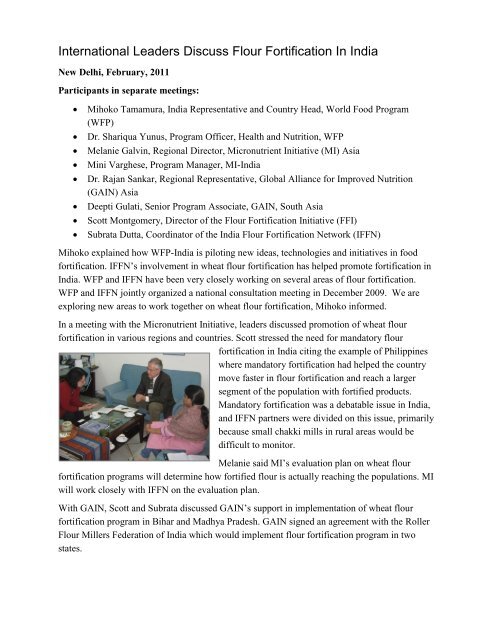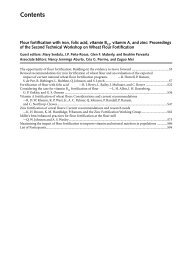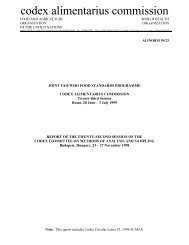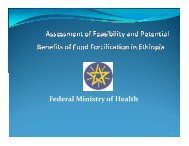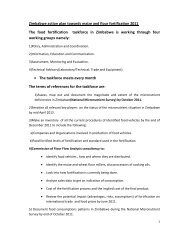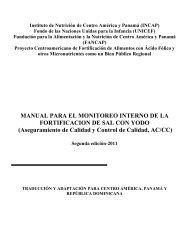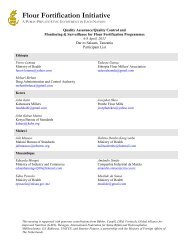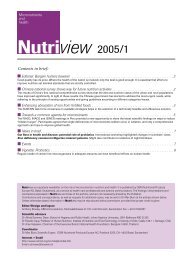International Leaders - Flour Fortification Initiative
International Leaders - Flour Fortification Initiative
International Leaders - Flour Fortification Initiative
Create successful ePaper yourself
Turn your PDF publications into a flip-book with our unique Google optimized e-Paper software.
<strong>International</strong> <strong>Leaders</strong> Discuss <strong>Flour</strong> <strong>Fortification</strong> In India<br />
New Delhi, February, 2011<br />
Participants in separate meetings:<br />
<br />
<br />
<br />
<br />
<br />
<br />
<br />
<br />
Mihoko Tamamura, India Representative and Country Head, World Food Program<br />
(WFP)<br />
Dr. Shariqua Yunus, Program Officer, Health and Nutrition, WFP<br />
Melanie Galvin, Regional Director, Micronutrient <strong>Initiative</strong> (MI) Asia<br />
Mini Varghese, Program Manager, MI-India<br />
Dr. Rajan Sankar, Regional Representative, Global Alliance for Improved Nutrition<br />
(GAIN) Asia<br />
Deepti Gulati, Senior Program Associate, GAIN, South Asia<br />
Scott Montgomery, Director of the <strong>Flour</strong> <strong>Fortification</strong> <strong>Initiative</strong> (FFI)<br />
Subrata Dutta, Coordinator of the India <strong>Flour</strong> <strong>Fortification</strong> Network (IFFN)<br />
Mihoko explained how WFP-India is piloting new ideas, technologies and initiatives in food<br />
fortification. IFFN’s involvement in wheat flour fortification has helped promote fortification in<br />
India. WFP and IFFN have been very closely working on several areas of flour fortification.<br />
WFP and IFFN jointly organized a national consultation meeting in December 2009. We are<br />
exploring new areas to work together on wheat flour fortification, Mihoko informed.<br />
In a meeting with the Micronutrient <strong>Initiative</strong>, leaders discussed promotion of wheat flour<br />
fortification in various regions and countries. Scott stressed the need for mandatory flour<br />
fortification in India citing the example of Philippines<br />
where mandatory fortification had helped the country<br />
move faster in flour fortification and reach a larger<br />
segment of the population with fortified products.<br />
Mandatory fortification was a debatable issue in India,<br />
and IFFN partners were divided on this issue, primarily<br />
because small chakki mills in rural areas would be<br />
difficult to monitor.<br />
Melanie said MI’s evaluation plan on wheat flour<br />
fortification programs will determine how fortified flour is actually reaching the populations. MI<br />
will work closely with IFFN on the evaluation plan.<br />
With GAIN, Scott and Subrata discussed GAIN’s support in implementation of wheat flour<br />
fortification program in Bihar and Madhya Pradesh. GAIN signed an agreement with the Roller<br />
<strong>Flour</strong> Millers Federation of India which would implement flour fortification program in two<br />
states.
Dr. Sankar noted that IFFN is a vibrant network which has involved all stakeholders in<br />
promotion of wheat flour fortification. India’s policy is very conducive, and there is huge<br />
opportunity to implement this program, Dr. Sankar pointed out.<br />
With a fragmented flour milling industry, India relies heavily on the industry for implementation<br />
of the fortification program. Other issues, like use of the recommended iron compound for high<br />
extraction flour, are still barriers for the flour fortification program. He stressed providing right<br />
exposure to the industry players. Such exposure to the champions from the milling industry and<br />
multi-nation companies would motivate them to start fortification of foods in India.<br />
Dr. Sankar discussed the differences between rice and wheat flour fortification and noted that<br />
comparative analysis of different rice fortification technologies are needed.


